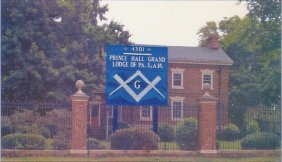The First black Masonic Lodge was founded at Prince Hall, Boston, in 1787. It was named after Prince Hall, who is recognized as the Father of Black Masonry in the United States. He made it possible for African Americans to also be recognized and enjoy all privileges of Free and Accepted Masonry.
Many rumors of the birth of Prince Hall have arisen. Few records and papers have been found of him either in Barbados where it was rumored that he was born, but no record of birth, by church or state, has been found there, and none in Boston. All 11 countries of the day were searched and churches with baptismal records were examined without a find of the name of Prince Hall.
 One widely circulated rumor states that “Prince Hall was free born in British West Indies. His father, Thomas Prince Hall, was an Englishman and his mother a free colored woman of French extraction. In 1765 he worked his passage on a ship to Boston, where he worked as a leather worker, a trade learned from his father. Eight years later he had acquired real estate and was qualified to vote. Religiously inclined, he later became a minister in the African Methodist Episcopal Church with a charge in Cambridge.” This account, paraphrased from the generally discredited Grimshaw book of 1903, is suspect in many areas.2
One widely circulated rumor states that “Prince Hall was free born in British West Indies. His father, Thomas Prince Hall, was an Englishman and his mother a free colored woman of French extraction. In 1765 he worked his passage on a ship to Boston, where he worked as a leather worker, a trade learned from his father. Eight years later he had acquired real estate and was qualified to vote. Religiously inclined, he later became a minister in the African Methodist Episcopal Church with a charge in Cambridge.” This account, paraphrased from the generally discredited Grimshaw book of 1903, is suspect in many areas.2
Black Freemasonry began when Prince Hall and fourteen other free black men were initiated into Lodge No. 441, Irish Constitution, attached to the 38th Regiment of Foot, British Army Garrisoned at Castle William (now Fort Independence) Boston Harbor on March 6, 1775. The Master of the Lodge was Sergeant John Batt. Along with Prince Hall, the other newly made masons were Cyrus Jonbus, Bensten Slinger, Prince Rees, John Canton, Peter Freeman, Benjamin Tiler, Duff Ruform, Thomas Santerson, Prince Rayden, Cato Speain, Boston Smith, Peter Best, Forten Howard and Richard Titley.
When the British Army left Boston in 1776, this Lodge, No 441, granted Prince Hall and his brethren authority to meet as African Lodge #1 (Under Dispensation), to go in procession on St. John’s Day, and as a Lodge to bury their dead; but they could not confer degrees nor perform any other Masonic “work”. For nine years these brethren, together with others who had received their degrees elsewhere, assembled and enjoyed their limited privileges as Masons. Thirty-three masons were listed on the rolls of African Lodge #1 on January 14th, 1779. Finally on March 2, 1784, Prince Hall petitioned the Grand Lodge of England, through a Worshipful Master of a subordinate Lodge in London (William Moody of Brotherly Love Lodge No. 55) for a warrant or charter.
The Warrant to African Lodge No. 459 of Boston is the most significant and highly prized document known to the Prince Hall Mason Fraternity. Through it our legitimacy is traced, and on it more than any other factor, our case rests. It was granted on September 29, 1784, delivered in Boston on April 29, 1787 by Captain James Scott, brother-in-law of John Hancock and master of the Neptune, under its authority African Lodge No. 459 was organized one week later, May 6, 1787.
Prince Hall was appointed a Provincial Grand Master in 1791 by H.R.H., the Prince of Wales. The question of extending Masonry arose when Absalom Jones of Philadelphia, Pennsylvania appeared in Boston. He was an ordained Episcopal priest and a mason who was interested in establishing a Masonic lodge in Philadelphia. Under the authority of the charter of African Lodge #459, Prince Hall established African Lodge #459 of Philadelphia on March 22, 1797 and Hiram Lodge #3 in Providence, Rhode Island on June 25, 1797. African Lodge of Boston became the “Mother Lodge” of the Prince Hall Family. It was typical for new lodges to be established in this manner in those days. The African Grand Lodge was not organized until 1808 when representatives of African Lodge #459 of Boston, African Lodge #459 of Philadelphia and Hiram Lodge #3 of Providence met in New York City.
Upon Prince Hall’s death on December 4, 1807, Nero Prince became Master. When Nero Prince sailed to Russia in 1808, George Middleton succeeded him. After Middleton, Petrert Lew, Samuel H. Moody and then, John T. Hilton became Grand Master. In 1827, Hilton recommended a Declaration of Independence from the English Grand Lodge.
In 1869 a fire destroyed Massachusetts’ Grand Lodge headquarters and a number of its priceless records. The charter in its metal tube was in the Grand Lodge chest. The tube saved the charter from the flames, but the intense heat charred the paper. It was at this time that Grand Master S.T. Kendall crawled into the burning building and in peril of his life, saved the charter from complete destruction. Thus a Grand Master’s devotion and heroism further consecrated this parchment to us, and added a further detail to its already interesting history. The original Charter No. 459 has long since been made secure between heavy plate glass and is kept in a fire-proof vault in a downtown Boston bank.
Today, the Prince Hall fraternity has over 4,500 lodges worldwide, forming 45 independent jurisdictions with a membership of over 300,000 masons.
